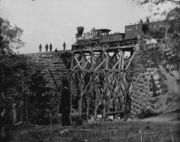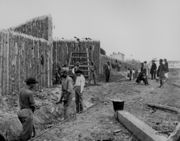Orange and Alexandria Railroad
The Orange and Alexandria Railroad (O&A) was an intrastate railroad in Virginia. It extended from Alexandria to Gordonsville, with another section from Charlottesville to Lynchburg. The road played a crucial role in the American Civil War, and eventually became an important part of the modern-day Norfolk Southern rail system.
Antebellum period
The Orange and Alexandria Railroad (O&A) was chartered by the Virginia General Assembly on May 28, 1848, to run between Alexandria to Gordonsville. Construction began in 1850 and was completed in April of 1854,when it connected with the Virginia Central Railroad in Orange County.
Also in 1854, the O&A was granted permission by the general assembly to build southward from Charlottesville to Lynchburg (O&A had to pay to use what are now known as trackage rights over the Virginia Central Railroad for a section from Gordonsville to Charlottesville). In 1860 the southern extension between Charlottesville and Lynchburg was completed with connections to the Virginia and Tennessee Railroad and the South Side Railroad. The O&A greatly benefited from the connection with these two railroads, as well as connecting with the Manassas Gap Railroad to the Shenandoah Valley at Tudor Hall (today named Manassas after this junction).
The end result was great for commerce in Virginia. Farmers could ship their products, produce and goods much more cheaply than before and could go any direction via the connecting railroad. Alexandria became a thriving seaport and manufacturing center. In addition to freight, passengers could go from Washington to Lynchburg in eight hours instead of the three-day travel before the railroad’s completion.
American Civil War
The O&A was strategically important during the Civil War (1861–65) and was arguably the most fought over railroad in Virginia. In connection with the Virginia Central, it was the only rail link that existed between the capitals at Washington, D.C., and Richmond. The importance of the link drew Union Army troops to the 1861 First Battle of Bull Run in an attempt to gain control of Manassas Junction. This important junction traded hands numerous time during the war. Confederate Maj. Gen. Thomas J. "Stonewall" Jackson took advantage of its importance by attacking it in the Battle of Manassas Station Operations to draw the Union into the 1862 Second Battle of Bull Run. The 1863 Battle of Brandy Station and Second Battle of Rappahannock Station were also fought near the railroad line.
Reconstruction
Following the war, the railroad found it was in dire shape. Much of the O&A track had been ripped up and most of the rolling stock destroyed. During Reconstruction, In 1867 the O&A merged with the Manassas Gap Railroad to become the Orange, Alexandria & Manassas Railroad. Then in 1873, the company was consolidated into the Virginia Midland Railway controlled by the Baltimore & Ohio Railroad. It later became part of the Richmond and Danville Railroad (R&D) and, in 1894 became an important piece of the Southern Railway System (SOU).
Modern times
In 1982, Southern Railway System joined the Norfolk and Western Railway to form the Norfolk Southern (NS) system. The former O&A tracks are also used by Amtrak and Virginia Railway Express (VRE) operates commuter railroad service along a portion of the historic line.


